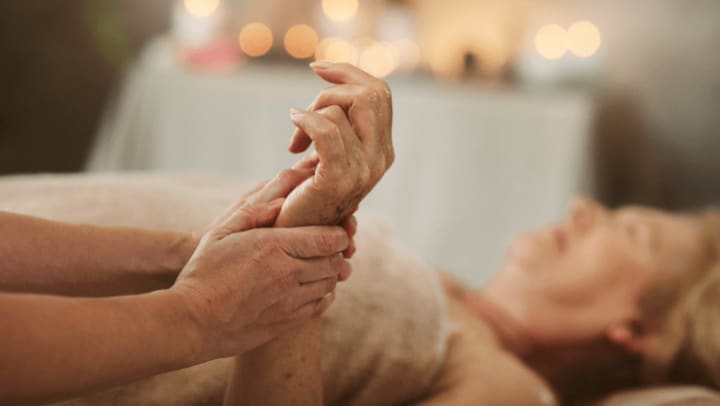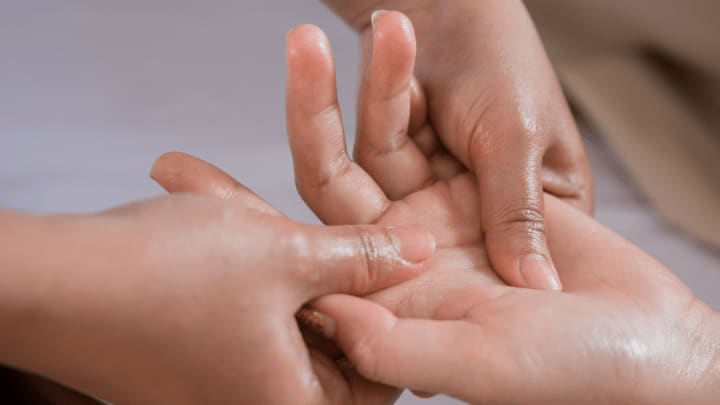Therapeutic touch serves as a cornerstone of senior wellness. This approach in memory care in Oklahoma City blends professional care techniques with lavender's soothing properties to create peaceful moments of connection. Family members can learn proper hand massage techniques to provide meaningful support to their loved ones.
This guide explains hand massage methods, proper pressure techniques and ways to build connections through therapeutic touch. These techniques have been adapted for senior communities, where customized attention meets professional expertise.
Anatomy and Sensitivities
Hand problems affect many seniors, with about 47% of people over 50 reporting hand issues and 31% experiencing hand pain. These problems can greatly affect daily activities, especially in older women. Common conditions include:
-
Osteoarthritis causes hand pain in older adults. It affects about 80% of seniors with hand pain and causes joint swelling and stiffness, making gripping objects difficult.
-
Carpal tunnel syndrome—About 5% of the population has this condition, which causes numbness, tingling and weakness in the hands.
-
Rheumatoid arthritis causes swollen, painful joints and surrounding tendons in the wrist and fingers.
Skin and tissue changes with age
Our hands change physically as we age, requiring special attention during massage. The epidermis gets thinner by about 6.4% every decade. The dermis shows reduced thickness, blood flow and cell count. These changes also mean:
-
The skin gets drier with up to 65% less lipid content
-
Less fat under the skin makes it more fragile
-
The body produces less collagen and elastin, reducing the skin's stretch
-
Healing takes longer - young skin heals in minutes, while aged skin needs over 24 hours
Nerve sensitivity considerations
Age changes how nerves work and how seniors feel touch. Old age leads to a loss of nearly 25% of motor axons in hand muscles. The touch-sensing mechanoreceptors decrease too. This means seniors might:
-
Feel pressure differently during massage
-
Be less sensitive to temperature changes
-
Have more vulnerable tissue
-
Experience numbness or tingling
Step-by-Step Hand Massage Protocol
A gentle hand massage protocol brings comfort to seniors receiving memory care in Oklahoma City. This step-by-step guide shows practical techniques that caregivers and family members can use. These techniques create meaningful moments of connection through therapeutic touch.
-
Preparation with warming techniques
The hands need proper warming to ensure better circulation and receptivity to touch. Start with these preparation steps:
-
Your hands should be rubbed together for 10-15 seconds to generate friction and warmth
-
Light stretching happens by opening and closing your hands several times
-
Small circles with your wrists in both directions boost flexibility
Hydrotherapy offers another quick way to warm up: alternate between warm and cool water (30 seconds in warm water, 10 seconds in cool water). This creates a pumping action that increases circulation in the hands.
-
Essential lavender oil application
Research shows lavender oil positively affects emotions and reduces aggressive behavior in seniors with dementia. The proper application involves:
-
Mix 6-10 drops of lavender essential oil with 30ml of unscented lotion or carrier oil like jojoba
-
A dime-sized portion should be warmed between your palms before application
-
Gentle, smooth strokes along both sides of the hand work best for applying
Note that seniors' skin becomes thinner and more fragile with age. Use minimal pressure when spreading the oil or lotion.
-
Pressure sequence from fingers to wrist
The caregiver should sit face-to-face with the senior, close enough to support their hand without pulling. Then:
-
The palm faces down while your thumbs make small circular motions around the wrist bones
-
Turn the hand over and use your thumbs to stroke the inside of the wrist toward the palm
-
Return to the palm-down position and massage between the long, thin bones on top of the hand
-
The pinkie finger comes first - gently pinch the base and slowly drag it toward the fingertip
-
Circular motions with your thumbs work best for finger joints
Essential Hand Massage Techniques for Beginners
Seniors can benefit from therapeutic hand pressure points. These spots on the hands create meaningful connections during massage sessions that help reduce pain and boost circulation.
-
Palm and finger pressure points: The hands feature several powerful pressure points that respond well to gentle stimulation during massage. Remember that your thumb should move in small circles for about a minute at each point. The person should feel a comfortable "dull ache" instead of pain.
-
Heart 7 point - This spot lies in the wrist crease between the ring and pinkie fingers. Gentle pressure here helps reduce anxiety and promotes better sleep
-
Hand valley point - Located in the webbing between the thumb and index finger, this point responds to moderate pressure to reduce stress and headaches
-
Base of thumb point - A gentle massage at the thumb's base can help with breathing difficulties
-
-
Gentle stretching movements: Simple stretches help aging hands stay flexible and reduce stiffness:
-
Finger pulls - Add a drop of lavender-infused oil to the hand. Your thumb and index finger should squeeze each finger's base and glide up
-
Hand opening - The senior's fingers should spread slowly apart, then close into a loose fist
-
Thumb stretches - The thumb moves across the palm and returns to its starting position
-
Building Connection Through Therapeutic Touch
Therapeutic touch goes beyond technique. It creates meaningful connections for seniors with cognitive challenges in memory care in Oklahoma City. These meaningful interactions improve overall well-being at Iris Memory Care of NW Oklahoma City.
Hand massage therapy is a powerful way to connect with seniors. Starting this experience might seem challenging at first, but professional guidance will help you perfect your technique—call (405) 252-8200 for expert advice.
Hand massage therapy provides more than physical comfort—it's a fantastic way to boost quality of life through gentle, mindful touch.


